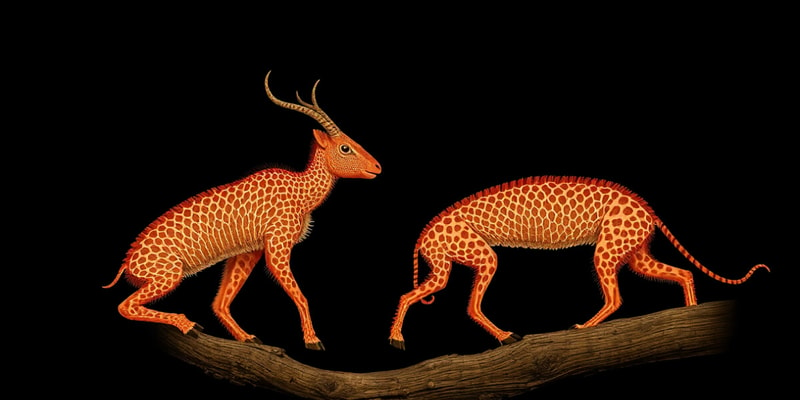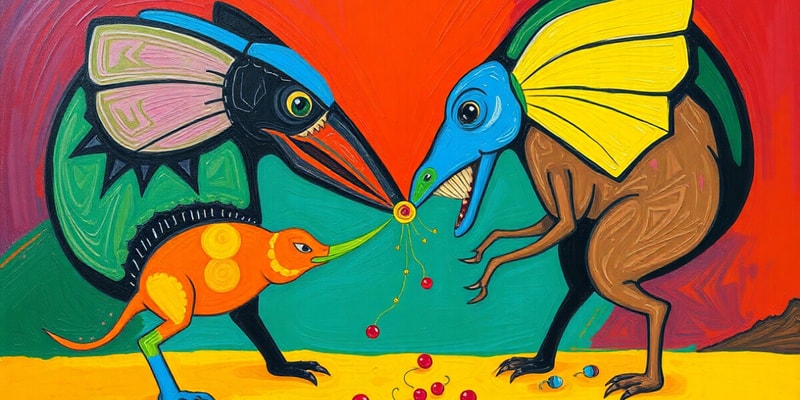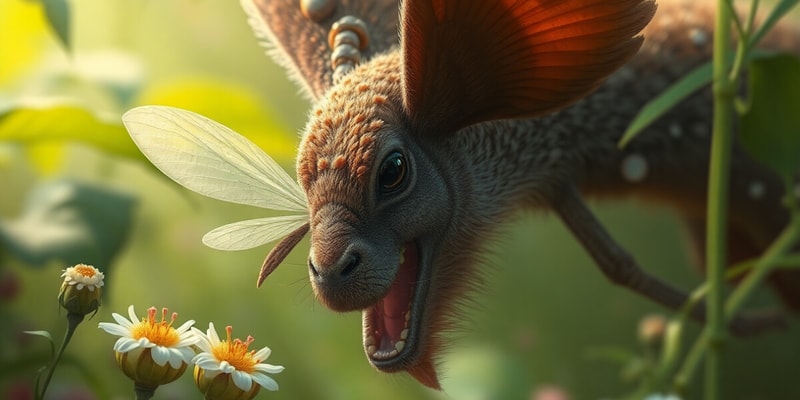Podcast
Questions and Answers
What is a trade-off that organisms face in reproduction?
What is a trade-off that organisms face in reproduction?
What does natural selection favor in terms of life histories?
What does natural selection favor in terms of life histories?
Which statement accurately characterizes r-strategy organisms?
Which statement accurately characterizes r-strategy organisms?
Which of the following is a characteristic of K-selection?
Which of the following is a characteristic of K-selection?
Signup and view all the answers
Why is it difficult for organisms to maximize fitness?
Why is it difficult for organisms to maximize fitness?
Signup and view all the answers
What characterizes a fast life history strategy?
What characterizes a fast life history strategy?
Signup and view all the answers
How do male Chinook Salmon differ in their life strategies?
How do male Chinook Salmon differ in their life strategies?
Signup and view all the answers
In what way do 'sneaker' males differ from more traditional male strategies?
In what way do 'sneaker' males differ from more traditional male strategies?
Signup and view all the answers
What role does frequency-dependent selection play in alternative strategies?
What role does frequency-dependent selection play in alternative strategies?
Signup and view all the answers
What is the usual outcome of intensive harvesting on species with alternative life histories?
What is the usual outcome of intensive harvesting on species with alternative life histories?
Signup and view all the answers
Which of these statements about sexually dimorphic species is true?
Which of these statements about sexually dimorphic species is true?
Signup and view all the answers
What leads to a decline in body size among bighorn sheep populations?
What leads to a decline in body size among bighorn sheep populations?
Signup and view all the answers
What can trigger the emergence of alternative reproductive tactics within a species?
What can trigger the emergence of alternative reproductive tactics within a species?
Signup and view all the answers
What feature is common among male dung beetles with respect to reproductive strategies?
What feature is common among male dung beetles with respect to reproductive strategies?
Signup and view all the answers
What defines the term sexually dimorphic?
What defines the term sexually dimorphic?
Signup and view all the answers
What happens to the fitness of rare reproductive strategies compared to common strategies?
What happens to the fitness of rare reproductive strategies compared to common strategies?
Signup and view all the answers
Why might sneaker strategies be advantageous in certain populations?
Why might sneaker strategies be advantageous in certain populations?
Signup and view all the answers
Study Notes
Costs of Reproduction
- Organisms cannot maximize all life-history traits simultaneously.
- There is a trade-off between traits, meaning an increase in one trait may lead to a decrease in another.
- For example, bright male guppies have high reproductive success, but they are more visible to predators.
- The cost of reproduction can vary, such as the increased risk of predation for brightly colored guppies.
Selection on Life Histories
- Evolutionarily successful organisms survive to reproduce and reproduce successfully.
- Natural selection favors genotypes that result in the highest fitness relative to other genotypes.
- This is a fundamental component of the meaning of life.
r-Selection vs. K-Selection
- Life histories can be categorized into r-strategy and K-strategy.
- r-strategy emphasizes rapid growth and fast reproduction, often with many offspring, while K-strategy emphasizes slower growth, reaching a stable maximum with fewer offspring.
- Examples of r-selected organisms include squirrels, while examples of K-selected organisms include sharks and humans.
Fast vs. Slow Life Histories
- Life histories can be further categorized into fast and slow.
- Fast life history is characterized by high fecundity, short lifespan, lots of offspring, and a young age of maturity.
- Slow life history is characterized by low fecundity, long lifespan, few offspring, and an old age of maturity.
Alternative Life Histories
- Life histories can vary within a species and multiple strategies can be successful.
- This can be seen in Bluegill Sunfish, where males can employ different reproductive strategies.
- Examples of alternative life histories include:
- Parental: Male guards eggs and cares for young.
- Sneaker: Smaller male quickly fertilizes eggs, a "dead-beat dad" strategy.
- This can lead to frequency-dependent selection, where the fitness of a particular strategy depends on the frequency of other strategies.
Harvest-Induced Evolution
- Intensive harvest can lead to genetic changes, driving earlier age of maturity and smaller size at maturity.
- Selective hunting of males with large horns has led to a decline in body size and horn length in Alberta's bighorn sheep.
- This demonstrates how human activities can influence the evolution of life histories, even leading to declines in populations.
Studying That Suits You
Use AI to generate personalized quizzes and flashcards to suit your learning preferences.
Related Documents
Description
Explore the fascinating concepts of reproductive costs and selection on life histories in this quiz. Delve into r-selection and K-selection strategies and understand how organisms balance trade-offs to maximize their fitness. Test your knowledge of these essential principles in evolutionary biology.




